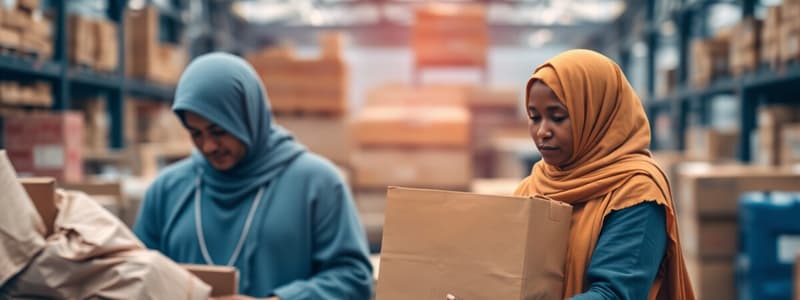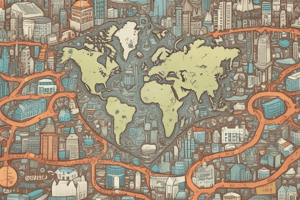Podcast
Questions and Answers
What was a significant reason for amending the report on 24 August 2020?
What was a significant reason for amending the report on 24 August 2020?
- To include an analysis of market trends
- To add new statistics about labor practices
- To correct formatting errors
- To reflect a statement by a company named in the report (correct)
How does the report address the ongoing corporate responsibility regarding the Xinjiang region?
How does the report address the ongoing corporate responsibility regarding the Xinjiang region?
- By emphasizing only positive practices by companies
- By providing a comprehensive breakdown of annual revenues
- By excluding any references to corporate involvement
- By linking the parent company to labor transfer schemes (correct)
Which aspect of supply chain transparency is highlighted in the report's amendments?
Which aspect of supply chain transparency is highlighted in the report's amendments?
- Changes in taxation policies affecting suppliers
- Improvement in labor conditions for workers
- Responses from companies named in the report (correct)
- Documentation of employment contracts
What impact on local communities does the report suggest through its updates?
What impact on local communities does the report suggest through its updates?
What amendment was made on 19 November 2020 related to corporate practices?
What amendment was made on 19 November 2020 related to corporate practices?
What should the Chinese government do to protect the rights of vulnerable ethnic minorities?
What should the Chinese government do to protect the rights of vulnerable ethnic minorities?
What action should companies take if they find instances of forced labor in their supply chains?
What action should companies take if they find instances of forced labor in their supply chains?
What is a potential consequence for companies using forced labor in their supply chains?
What is a potential consequence for companies using forced labor in their supply chains?
Which approach contributes to corporate responsibility regarding labor practices?
Which approach contributes to corporate responsibility regarding labor practices?
How should the Chinese government respond to allegations of forced labor?
How should the Chinese government respond to allegations of forced labor?
What was the primary outcome of the ICPC's international visits program?
What was the primary outcome of the ICPC's international visits program?
Which option best describes the disclaimer regarding the publication's content?
Which option best describes the disclaimer regarding the publication's content?
What significant change occurred regarding The North Face in the publication?
What significant change occurred regarding The North Face in the publication?
Which of the following best reflects concerns related to transparency in supply chains?
Which of the following best reflects concerns related to transparency in supply chains?
In what way does corporate responsibility extend to local communities in the context of the content?
In what way does corporate responsibility extend to local communities in the context of the content?
What amendment was made in regard to the endnotes in the publication?
What amendment was made in regard to the endnotes in the publication?
How did the publication address the addition of responses from companies?
How did the publication address the addition of responses from companies?
Which practice is commonly criticized within the textile industry regarding the content provided?
Which practice is commonly criticized within the textile industry regarding the content provided?
Flashcards
Forced Labor in China
Forced Labor in China
The exploitation of workers through coercion, often involving vulnerable ethnic minorities, denying them the right to control their work and living conditions.
Multinational Company Responsibility
Multinational Company Responsibility
Multinational companies should conduct thorough investigations into potential forced labor practices and take remedial actions to stop such practices.
Chinese Government Obligations
Chinese Government Obligations
The Chinese government needs to protect workers' rights, implement a robust grievance mechanism for dealing with forced labor cases, and ratify international labor standards
Supply Chain Risk Disclosure
Supply Chain Risk Disclosure
Signup and view all the flashcards
Human Rights Due Diligence
Human Rights Due Diligence
Signup and view all the flashcards
Report Amendments (2020-2022)
Report Amendments (2020-2022)
Signup and view all the flashcards
Page 38 Amendments
Page 38 Amendments
Signup and view all the flashcards
October 2020 Update
October 2020 Update
Signup and view all the flashcards
November 2020 Correction
November 2020 Correction
Signup and view all the flashcards
Cross-referencing addition
Cross-referencing addition
Signup and view all the flashcards
ICPC International Visits Program
ICPC International Visits Program
Signup and view all the flashcards
ASPI Publication
ASPI Publication
Signup and view all the flashcards
Copyright Restrictions on the Publication
Copyright Restrictions on the Publication
Signup and view all the flashcards
Report Updates
Report Updates
Signup and view all the flashcards
Forced Labor Accusations
Forced Labor Accusations
Signup and view all the flashcards
Supply Chain Investigation
Supply Chain Investigation
Signup and view all the flashcards
Company Responses
Company Responses
Signup and view all the flashcards
Educational Institutions' Copyright Permissions
Educational Institutions' Copyright Permissions
Signup and view all the flashcards
Study Notes
Uyghurs for Sale
- Chinese government facilitating mass transfer of Uyghur and other ethnic minority citizens from Xinjiang to factories across China.
- Workers are in factories supplying well-known global brands (e.g., Nike, Apple, BMW).
- Conditions strongly suggest forced labor.
- Uyghurs are segregated in dormitories.
- Undergo language and ideological training.
- Constant surveillance.
- Forbidden from religious practices.
- Limited freedom of movement.
- Some sent directly from detention camps.
Xinjiang's Labor Transfer Program
- More than 80,000 Uyghurs transferred 2017-2019.
- Xinjiang provincial government pays local officials and brokers per transferred Uyghur.
- Jobs transfers are now a crucial part of 're-education'.
- Workers assigned minders.
- Extensive monitoring and surveillance.
- Factories have watchtowers, razor wire, and police guard posts.
- Workers' families are monitored.
- Often paid less than Han counterparts.
Forced Uyghur Labor
- ILO has 11 indicators of forced labor.
- Relevant indicators include intimidation, surveillance, restricted movement, abusive conditions, excessive hours, and isolation from families.
- Chinese state media claims labor transfers are voluntary, but Uyghur workers who have left China report fear of returning to detention camps.
- Workers live in segregated dormitories, monitored closely by police or minders.
- Forced to attend Mandarin classes and participate in ideological training.
- Prohibited from religious practices.
Case Studies
- Case Study 1 (Nike): Uyghur workers in Qingdao making Nike sneakers.
- Case Study 2 (Re-education to Forced Labor): Uyghur workers transferred from Xinjiang re-education camps to factories in eastern China (e.g., the Haoyuanpeng factory).
- Case Study 3 (Apple's Supply Chain): Uyghur workers making components for Apple products (e.g., O-Film).
Implications for the Global Supply Chain
- 82 international companies, directly or indirectly, are potentially benefiting from Uyghur labor.
- Forced labor schemes raise legal and reputational risks for companies.
- Companies should conduct human rights due diligence in their supply chains.
Recommendations
- Chinese government should allow independent investigations into forced labor practices.
- Uphold rights of all workers (especially minorities) to choose where and how to work.
- Ratify ILO conventions related to forced labor.
- International companies should conduct thorough human rights training and due diligence on their supply chains.
- Consumers should push for companies to ensure their products are not made with forced labor.
Studying That Suits You
Use AI to generate personalized quizzes and flashcards to suit your learning preferences.




